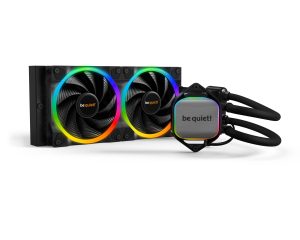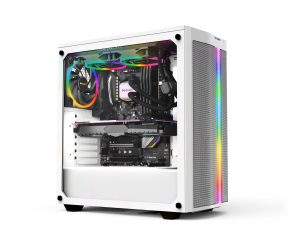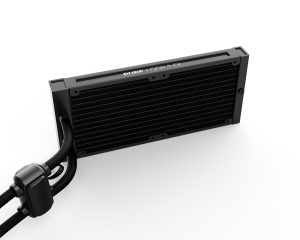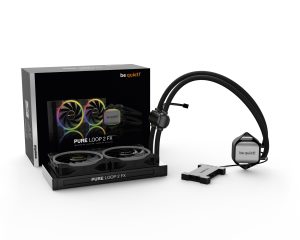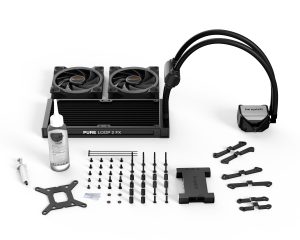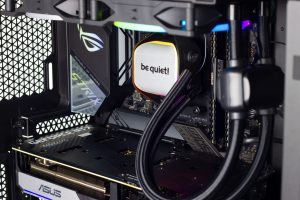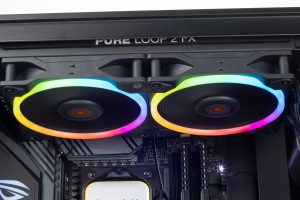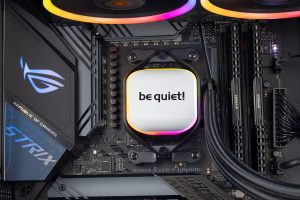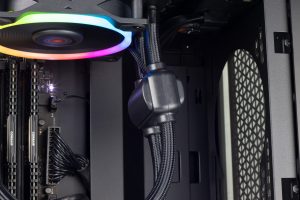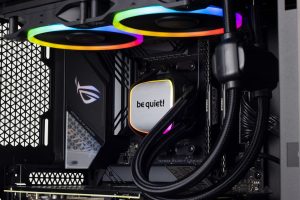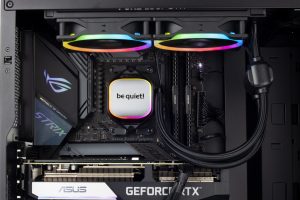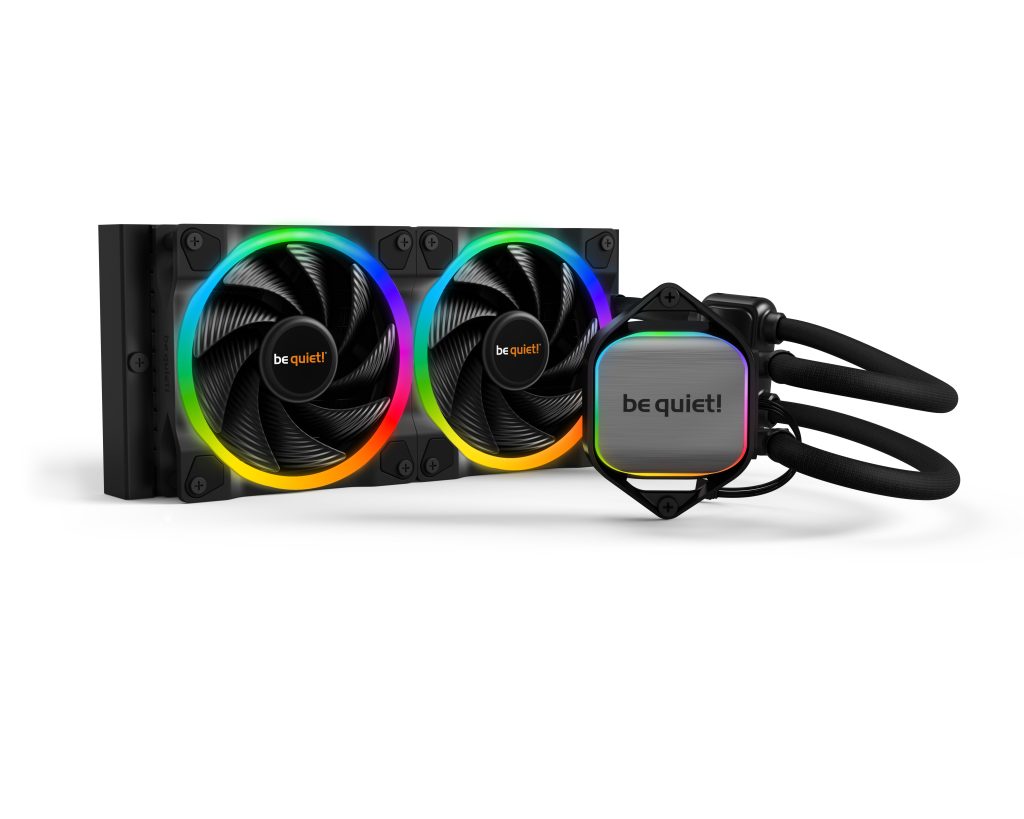
The new be quiet! Pure Loop 2 FX continues the trend of top notch build quality found in be quiet!'s line of products, with a sprinkle of ARGB to boot. Similar to the Pure Loop, the pump design in the Pure Loop 2 FX isn't what you'd expect with an AIO.
With a "doubly decoupled" in-line pump that is advertised to run quieter and smoother than other solutions, that is now PWM controlled, with an RRP of £129.99, let's deep dive into what this newly released AIO on be quiet!'s 20th anniversary has to truly has to offer.
TL:DR - Pros and Cons
- Included fan/ARGB hub with standardised ARGB connectivity
- No proprietary software or connectors
- Fill port with 100ml included extra coolant for longevity
- Plethora of included socket mounting and clear instructions
- Very quiet pump operation
- Good Performance
- Clunky tubing due to in-line pump
- Less than ideal cable management due to in-line pump
- mediocre fan lighting when compared to the competition
- CPU block not multi-directional
Pure Loop 2 FX Technical Details
Below is a breakdown of all the technical specs and what's included in the Pure Loop 2 FX box.
- Radiator Size - 240mm
- Radiator Dimensions (WxDxH) - 120 x 52 x 277mm
- Radiator Material - Aluminium
- CPU Block Material - Nickel Plated Copper
- Total Weight Including Fans - 1180g
- TDP - Not Listed by be quiet!
- Fan speed 100% (PWM) - 2500rpm
- Fan Lighting Connectivity - 5v 3-pin ARGB connector
- Socket Compatibility Intel - 1700/1200/2066/1150/1151/1155/2011(-3)
- Socket Compatibility AMD - AM5/AM4
- be quiet! Pure Loop 2 FX CPU cooler
- x2 be quiet! Light Wing 120mm ARGB fans
- be quiet! mounting for listed sockets
- Instruction pamphlet and warranty information
- Fan and lighting controller
- Spare clear be quiet! coolant for refilling

Testing Specification
For thermal testing we use a range of different software to stress the CPU including CineBench R23, Prime 95 Blend and Aida64 utilising AVX based tests. Temperatures are recorded using Aida64's temperature logging.
Fan or pump speed (RPM) is not manually set or throttled for sound testing. The noise testing is set to mimic the end user experience for what can be expected under general use when following each cooler's manual or set up guide. Whilst this isn't a definitive test or comparison to the quality of each fan that comes with an AIO, its closer to the conditions you may experience.
Room ambient temperature is monitored and recorded before, during and after our testing and a Delta is calculated for the temperature over the recorded ambient room temperature which is used in all of our temperature charts. The CPU performance-core clock is locked 4.0 GHz and CPU core voltage is locked to 1.33v. Thermal paste that comes with each cooler is always used to mimic user experience.
- CPU - AMD Ryzen 7 5700X
- Motherboard - ROG STRIX X570-F
- RAM - 16GB Corsair Vengeance LPX 3000 MHz (2 x 8GB)
- SSD - Samsung 1TB 980 Pro
- PSU - Corsair RM850x 850W
- GPU - Nvidia RTX 3060 Ti
- Case - Corsair 4000D Airflow
Performance & Temperature
On to what matters, how well does this cooler perform. In short, very well. Whilst this is the first cooler we put under the spotlight when it comes to our cooler round up, its certainly held its own and is in line with what we'd expect. We've already explained our testing methodology so we'll just dive into the results.
VRM Surface Temperature
First of is VRM surface temperature. This category is becoming increasingly important with the insane lengths modern motherboards are going to as well as new AIO options that are fitting VRM cooling fans to their blocks in an attempt to shift hot, pooling air in less optimised conditions.
Our chassis configurations doesn't have any extra fans pulling hot air out of the way to get a direct comparison between AIO blocks that both do and don't have a VRM fan.
VRM Surface Temperature Idle
27.6c
VRM Surface Temperature Under Load
40.8
Benchmark Temperatures
Below is graph with the results from our 3 CPU benchmarking tests. Each temperature listed is the delta over ambient temperature which was monitored and controlled for each test. The be quiet! Pure Loop 2 FX performs favourably here on a modern Ryzen 7 5700X.
Compatibility & Ease of Use
Being a 240mm AIO, as always, the actual case compatibility is going to be good. The total AIO thickness with the standard 25mm Light Wing fans included is 52mm. With all AIOs, clearance above your RAM will depend on your RAM dimensions specifically.
However, with the irregular pump design choice, there is another factor when it comes to fitting the AIO in your case. With the in-line pump, both manipulating the tubes for any placement, or fitting them around a long graphics card if needed for certain positions, is a lot more difficult than usual.
This means the two locations for the AIO that we'd recommend is in the top of a chassis or at the front with the tubes orientated up rather than down. With a unique pump placement, any air getting trapped in there is very unlikely, which is what helps when it comes to acoustics, and you can always use the included coolant and fill port to ensure your AIO is constantly brimmed.
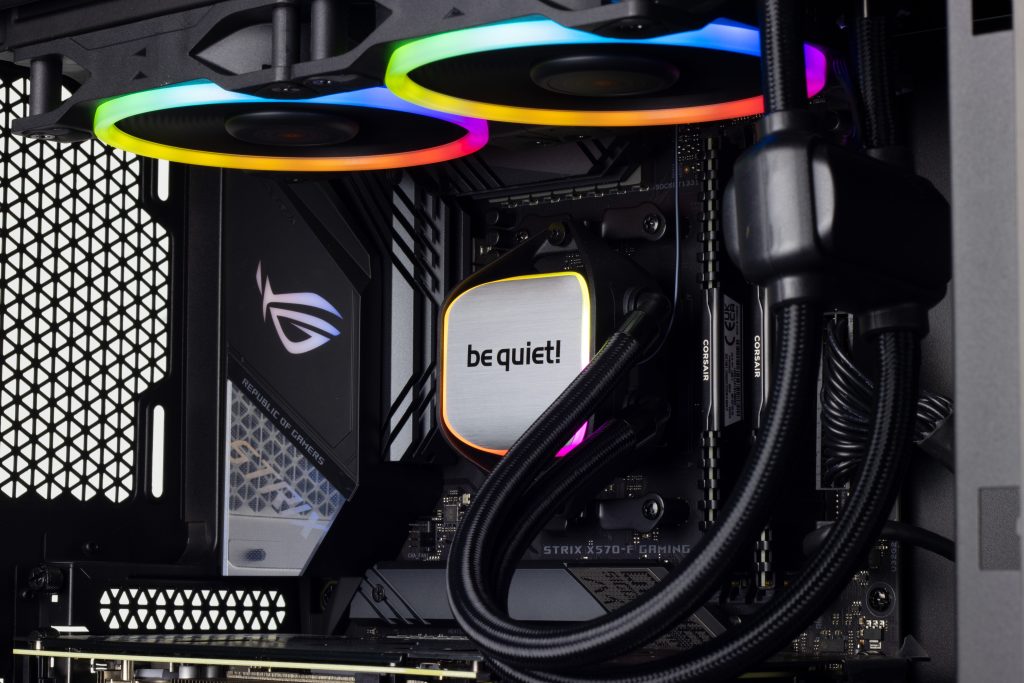
Fans, Cables and Controller
The included fan hub and ARGB controller is nice to see and even nicer to use. The controller has enough space for all 3 ARGB connectors that come from the 2 fans and the block as well as the 4-pin PWM connectors from the fans and the pump itself. The hub requires SATA power and only one output to both ARGB (motherboard) and a PWM fan header (CPU_FAN).
The hub has 2 possible mounting options, either using the included 3M double sided foam pad, or mounting to an SSD tray. We opted to mount the hub using the SSD trays in the Corsair 4000D Airflow, which caused a small problem.
SSD trays are commonly located either behind the motherboard tray or atop a PSU shroud on most cases. If you want to utilise your controller by plugging in your CPU block lighting to it, these locations are going to be too far away for the short cable coming off the CPU block. So it's likely you'd want to place the hub a little higher and use the 3M pad instead.
CPU Socket Mounting
The Pure Loop 2 FX has a plethora of mounting included with the cooler. The compatibility is listed for the majority of Intel socket's including LGA2066 and the latest LGA1700 socket out of the box. Furthermore both AM4 and the new AM5 socket from AMD is supported.
The mounting we used was for AMD's AM4 socket, whilst solid, it's a little different to 2 of the more traditional styles of AM4 mounting. Normally a cooler will either use the pre-fitted AM4 clamps to synch the block down, or opt for their own backplate and mounting entirely.
The Pure Loop uses a bit of a hybrid. Opting to replace the clamps with two plates where the block then screws down into. Its a solid fitment but less convenient than using the pre-installed clamps and still has the downside of only having two points of mounting pressure on opposing sides of the block. Whereas other solutions for replacing the default clamps tend to opt for four points of mounting pressure.
Aesthetics
The overall aesthetics of the Pure Loop 2 FX are a bit of a hit and miss. We feel the positives come from the block design with a clean brushed look and some tame but fitting ARGB around the circumference. The tube braiding is also very tidy but not something that tends to be looked at.
be quiet! fans have historically prioritised acoustics and performance over aesthetics and we still feel this rings true, even if some ARGB has been added to the light wing fans. The light ring that syncs using motherboard software through an ARGB header, in our case ASUS' Armory Crate, isn't very impressive. LED diffusion and density could be better, as we're able to identify individual lights through the frosted exterior. The colour palette is similar to the CPU block but doesn't quite match the smooth flow that the CPU block has.

A black rectangle for a radiator is to be expected in many cases and not particularly a focus for looks. But the pump situation for be quiet!'s Pure series is. The in-line pump doesn't look good, period. Of course its bonus for sound and performance probably outweigh this for a lot of people, but bare in mind you'll have a big block hanging somewhere in your build that also has a cable running to it.
Acoustics
Our sound testing isn't configured to test the ability of the light wing fans but designed to give an overall user experience when using the AIO for its intended purpose in its instructed configuration. A decibel (dB) reading is taken 20cm away from the fans (intake) with no obstruction when idle and under load, as well as 20cm from behind the radiator.
All readings were taken using a professional sound level meter in a quiet room with an ambient sound level of 30 dB
20cm in front of radiator fans (Idle) - 32.6 dB
20cm behind radiator (Idle) - 36.4 dB
20cm in front of radiator fans (load) - 52.7 dB
20cm behind radiator (Load) - 57.8 dB
Usability and Software
No proprietary software is required for the be quiet! Pure Loop 2 FX which is always great news. The ARGB connectivity is standard and will use the software specific to your motherboard. This may end up being Mystic Light by MSI if you have a motherboard from them. In our case it was ASUS Aura via Armory Crate for lighting control which worked as expected, and allowed ARGB sync between the ROG Strix X570-F motherboard and the Pure Loop 2 FX.
The AIO does come with its own hub but it isn't a requirement to use the cooler and all of its features. Its mainly just a fan controller and lighting splitter for standard cables, you could still choose to plug everything into your motherboard directly if you had the connectors to do so. The fans and block do not have chainable ARGB connectors so you'd require three of each in order to do this however. Not being chainable isn't a problem with the included hub that has even more connectors than necessary, for other lighting you may have.
Conclusion
The be quiet! Pure Loop 2 FX is a great evolution of the Pure Loop series, offering some much requested features such as the PWM controlled pump. Innovations in the pump design could be a tipping point in your purchasing decisions if you really care about AIO pump noise. We are awarding the be quiet! Pure Loop the UKGC Design Innovation Award for its progress in AIO pump design.

The AIO isn't in contention for prettiest of the year to us, be quiet! has a very well defined brand and design so would work well in a be quiet! themed build if you were focused on aesthetics. At an RRP of £129.99 it puts itself firmly in the middle ground of 240mm AIOs, which is to be expected given its not their premium level cooling solution.
Below is a comparison graph for all of the AIOs we have tested with our new methodology. It may be a little bare now but will update over time when more coolers are tested and compared.
Gallery
